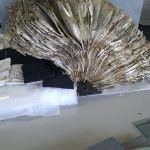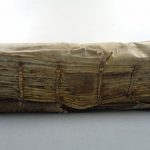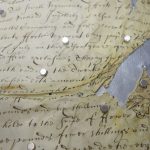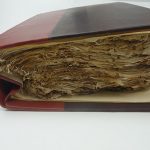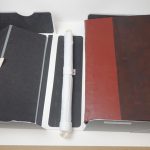Of more than 11 million documents in The National Archives’ collection, approximately 5,700 have been identified as “unfit for production’’ due to their fragile physical state, which means that they cannot be seen by readers without prior conservation treatment. This may involve basic cleaning, but in some cases can include more substantial treatments. To allow access to ”unfit documents”, the Collection Care department works systematically – and sometimes on demand – to tackle the varied and often complex challenges posed by records that are often extremely fragile.
This 17th century binding (E 403/2570, 1655-1659), from the Office of First Fruits and Tenths and the Court of Augmentations, is one example. Severe damage had made access to this document virtually impossible (fig.1).
- (fig. 1) E403 2570 before treatment
- (fig.2) E403/2570 cleaned sewing supports
At some point in its 350-year history the parchment volume has been damaged by heat and possibly by water, causing it to shrink and block together and meaning that many of its pages could not easily be pried apart. Gelatinisation – when parchment collagen turns into water-soluble gelatine – had occurred as a reaction to substantial fluctuations in temperature and moisture, irreparably breaking down the parchment fibres.
Although the original sewing of the binding was intact, its supports were degraded and what remained of the original boards provided no protection to the fragile and torn edges (fig.2). The shrinkage of the parchment had severely distorted the spine into a concave shape, making the volume impossible to open and read.
- (fig. 3) E403/2570 during treatment
- (fig.4) E403/2570 magnets in creased area
One approach to conservation would have been to remove the original sewing supports, sacrificing the sewing altogether, to allow the separation and flattening of individual sheets of parchment. While this would have sped up the conservation process it would also have radically changed the volume’s historical format, which we were keen to maintain. We therefore opted for an innovative in-situ technique that required far less intervention (fig.3).
To flatten the creases of individual pages, a minute amount of moisture was applied to the damaged parchment using small pieces of dampened capillary matting. With the help of a thin sheet of metal, tiny but strong magnets (fig.4) were placed on the parchment to stretch it out and hold it in position, thereby forcing it to dry flat. This significantly reduced the volume’s bulk and helped to restore its original size and shape (fig.5).
- (fig.5) E403 2570 after treatment
- (fig.6) E403/2570 volume in bespoke box
The traditional method of stretching parchment – clipping the individual sheets to a board after breaking down the binding – was therefore avoided. It was the first time we have attempted this far less destructive conservation process in a bound volume, and it proved highly successful in making the volume accessible to the general public once again. (fig.6).
Read a full description of the treatment in the Journal of the Institute of Conservation.
The Institute of Conservation is also running a two-day workshop at The National Archives on the conservation, preservation and science of parchment. Under the Skin: Studies in Parchment takes place on the Thursday 19 and Friday 20 October 2017. The event is ticketed so if you’d like to attend please register.

